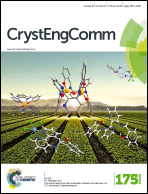Self-assembly of TATB 3D architectures via micro-channel crystallization and a formation mechanism†
Abstract
Three-dimensional (3D) hierarchical nanostructures with a controlled morphology and dimensionality represent one kind of important materials and have received enormous attention for a series of applications. We demonstrate a micro-channel directional crystallization process to assemble TATB 3D architectures. Chrysanthemum-like 3D architectures with a size of 2 μm were self-assembled by many TATB nanorods, of which the length and diameter is ∼1 μm and ∼40 nm, respectively. A 1D nanorod structure was formed due to the driving-force gradient of an initial crystallite and further growth along a certain direction. The nanostructure of TATB can be tuned by changing the diameter of the micro-channel and a 3D microsphere assembled by nanowires with a diameter of ∼30 nm and a 1D shuttle-like nanostructure with a diameter of ∼50 nm can be successfully prepared. The nanostructure of TATB has a great influence on the thermal decomposition and kinetics of TATB due to its high surface area that contributes to efficient mass transfer and heat transfer, thus leading to numerous activated molecules being involved in the reaction. We believe that this approach will open doors to a range of interesting studies related to nano-energetic material fabrication.


 Please wait while we load your content...
Please wait while we load your content...